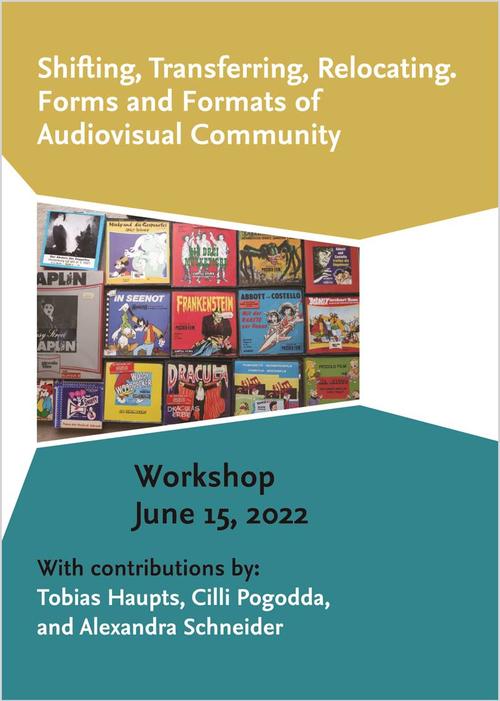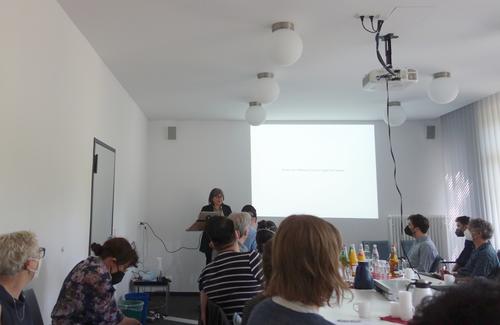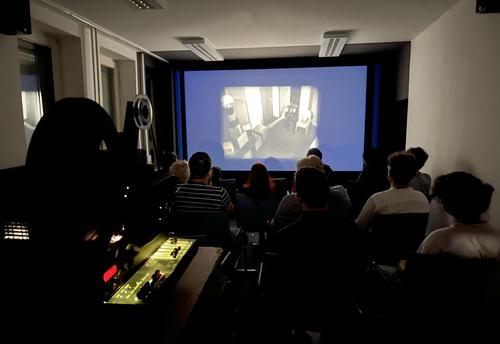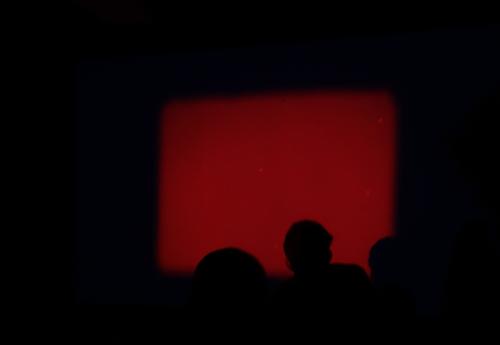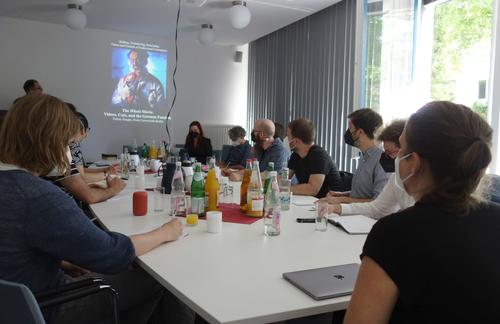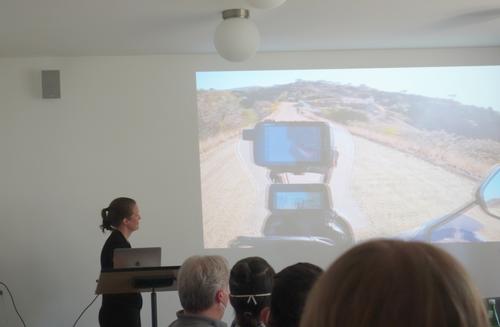Shifting, Transferring, Relocating. Forms and Formats of Audiovisual Community
15.06.2022 | Workshop der Kolleg-Forschungsgruppe Cinepoetics mit Alexandra Schneider, Tobias Haupts und Cilli Pogodda.
Research Focus: Audiovisual Cultures
The full-day workshop started with an introductory statement by Matthias Grotkopp on how cultures and communities articulate themselves in different forms and formats that, however, must be continuously reflected upon.
In the first presentation "Audiovisual Cultures of Super-8 Reduction Prints. Tracing a Liminal Practice," Alexandra Schneider introduced the workshop participants to her ongoing research on super-8 reduction prints, followed by a joint screening of three different films on a super-8 film projector.
In presenting these prints as a dispositive with a mainly domestic and non-theatrical purpose in the 20thcentury, she also pointed out their newly risen relevance for archival purposes, as these reduction prints may be in some cases the only remains of the original film material.
Alexandra Schneider introduces the format of Super8 reduction prints
Impressions from the Super8-Screening I
As altered feature length films, they became a new and easier available film experience, which Schneider proposed to define as a liminal format. While focusing on the (dis)continuities of tracing the circulation processes, she also pointed out the cheaper availability of the film material for a domestic purpose and screenings in alternative spaces, resulting in a forming of a collector and fan scene. Schneider closed her presentation by outlining her theoretical aims for this ongoing research. She wants to redirect and investigate frames of perspectives, taking a look at what is commonly overlooked and found on the edges of current film study.
The following discussion centered around the specific aesthetics of super-8 cameras as well as their historicity and object-character. Furthermore, the group discussed the affective attachment to this viewing experience as it is connected to the particularly cut film material one owns.
After the lunch break, Tobias Haupt’s presentation "The Whole Movie. Videos, Cuts, and the German Fandom" aimed to explore cutting procedures of German VHS-releases of horror films and the intricacies of fan-made cut reports and fanzines.
This practice of cut reports began in the late 1970s and included detailed descriptions of certain scenes that have been cut from the film. Hence, these reports can be seen as a list of evidence but also as a documentation of censorship under the development of different guidelines. This led to the forming of fan-made magazines as well as early web-communities, correcting and editing their own cut reports and film versions, as well as watching films with a newly grown suspicion of whether certain films were cut differently. Furthermore, a new aesthetic of horror emerged from this, as fans-turned-directors like Jörg Buttgereit started making films.
This practice of cut reports began in the late 1970s and included detailed descriptions of certain scenes that have been cut from the film. Hence, these reports can be seen as a list of evidence but also as a documentation of censorship under the development of different guidelines. This led to the forming of fan-made magazines as well as early web-communities, correcting and editing their own cut reports and film versions, as well as watching films with a newly grown suspicion of whether certain films were cut differently. Furthermore, a new aesthetic of horror emerged from this, as fans-turned-directors like Jörg Buttgereit started making films.
The following group discussion focused on the cut film material and the resulting incompleteness mentioned in both presentations. Also, next to protecting certain groups of viewers these cuts could be seen as censorship enforced by the FSK guidelines, which shaped film circulation within these communities.
In the last presentation, "Mounting the GoPro, Riding the World: How Motorcycle Travelers Create Audiovisual Formats of Shared Sensibilities," Cilli Pogodda gave an insight to her most recent research on the relationship between technology and affect in regard to female GoPro-communities.
Tobias Haupts talks about VHS cut reports in Germany
An analysis of the GoPro-community of female motorcyclists by Cilli Pogodda
In using GoPro-cameras attached to helmet or bike of the motorcycle traveler and drones documenting the landscapes and their movement through the landscapes, a feeling of celebration of loneliness is built, especially by sharing it online. In fact, following Pogodda, these videos are not simply about documenting the trip but about experiencing something and expressing it at the same time, all contained within the image.
In the discussion, the group exchanged their thoughts on the staging of moving through landscapes and how these videos mirror reflect the traveler’s actions. The place of the community as being-shared was seen as becoming part of the formatting, while travel may be reduced to a mere traversing through the space. Lastly, aspects of the touristic gaze and a potential reframing of illusions were mentioned as a prospect.
In the closing discussion, the participants focused again on the concept of liminality and the references of the in-between. They also emphasized the question whether something can be complete and how we are attached to different (incomplete) objects while questioning the whole. Hence, formats may not be seen as a concept but rather a process, forming a cultural discourse, and therefore linking the final discussion to the current research focus audiovisual culture.
